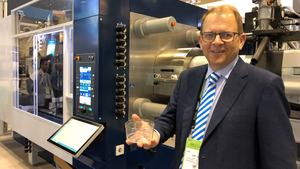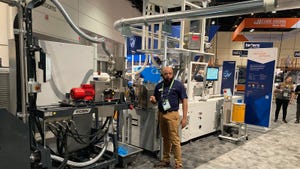3D-printed conformal cooling channels for injection molds improve productivity
Conformal cooling technology in injection molds has been around for a couple of decades. It was developed as a way to create cooling channels that follow, or conform, to the shape of the molded part in order to get cooling close to critical areas that otherwise would be difficult to cool, such as thicker wall sections. Conformal cooling technology offers a more uniform way to cool parts, thus reducing cycle time and improving productivity and quality.
April 4, 2014
In fact, cooling is an extremely critical part of the injection molding process, and over the past few years there have been several new developments in the technology in an effort to improve the way conformal cooling lines are produced to prevent leakage and mold damage. The advent of 3D printing, aka additive manufacturing, using the direct metal laser sintering (DMLS) process, developed by EOS GmbH, has given conformal cooling technology a new opportunity to improve the molding process with conformal cooling channels in injection molds.
Linear Mold & Engineering became a leader in these efforts when the company obtained its first DMLS machine from EOS GmbH in 2007. As a premier designer of injection molds with complex geometries for the automotive, aerospace, and consumer products industries, Linear already knew of the advantages that conformal cooling could bring to the molding process. Being introduced to DMLS gave Linear new opportunities to provide this unique cooling channel technology not only to the molds it built for its OEM customers, but to other moldmakers, as well.
Consequently, over the past seven years, the interest in 3D-printing technology—and DMLS for a variety of components including conformal cooling lines—has picked up exponentially. What is driving this interest? Lou Young, Director of New Business Development for Tooling and Manufacturing for Linear, says that the spotlight on the 3D-printing process certainly helped.
"The DMLS process provides an optimal way to build conformal cooling lines that offer a better option for injection molds that require conformal cooling," Young explains. "Building molds with laminated conformal cooling plates never really caught on—no one wants to build molds in tiny little sections. Using DMLS or the selected laser melting process gives a lot more validity to the molding process in being able to hold molding pressures without the potential for leakage. It provides a more robust process."
OEM interest has been high in the aerospace industry, most likely because GE Aviation has led the way by acquiring a large 3D-printing service bureau. However, interest in 3D printing's opportunities for improving the injection molding process through DMLS conformal cooling channels in the automotive OEM community has been lacking.
John Tenbusch, founder and president of Linear Mold & Engineering, notes, "The OEM automakers are starting to discover conformal cooling and the possibilities that it has for injection molding. However, it's been flat in that industry. There has been some activity among OEMs, and some of the big automotive moldmakers are coming to us to find out more about this technology. That will pick up pretty heavily, I believe, just because there is so much interest in 3D printing now, where there wasn't before."
Young adds that reducing cost is at the forefront of the automotive industry's goals with its suppliers. "One way to reduce the cost of the many plastic components in vehicles is to reduce cycle time," he says. "And one way to do that is to integrate conformal cooling channels into the mold. One of the first major tooling projects we did for the automotive industry was for an HVAC part."
Another concern among automotive and Tier 1 suppliers is the capacity of sub-tier suppliers to meet vehicle production demands. "By improving the cycle time through conformal cooling, [we can] run one machine with one material without having to do numerous mold changeovers. We can dedicate a machine to a specific material," Young comments. "Additionally, there is lower capital investment with conformal cooling. You buy fewer injection molding machines and yet get higher productivity from each machine. And, you can invest in smaller cavitation molds rather than high-cavitation molds because the cycle time in a conformally cooled mold is much less, resulting in greater productivity. Also, a smaller mold means a lower-tonnage press is required, also resulting in cost savings."
Young also noted that many OEMs are trying to reduce the footprint of the mold by putting the cavities closer together. "We're doing smaller channels, and building cooling lines for areas where you could not get cooling lines before," says Young.
For larger parts, building conformal cooling channels means engineers can get the water where they need it most to create better cooling in a more uniform manner and eliminate hot spots, thus reducing cycles and improving quality.
Some markets have been faster to adopt DMLS conformal cooling channels than others. For example, the appliance, consumer packaging, and consumer goods markets have been interested in this technology for quite some time. The automotive market is just beginning to sit up and take notice.
Additionally, using Moldex 3D-simulation programs, Linear Mold & Engineering can perform FEA prior to designing the mold. "This allows us to be more aggressive with our water lines, identify hot spots, and get the lines closer to the surface of the part," states Young.
Linear also has invested in molding capabilities to provide mold tryouts and processing validations to help OEMs reduce the time that it takes to become production ready or achieve PPAP certification.
About the Author(s)
You May Also Like



